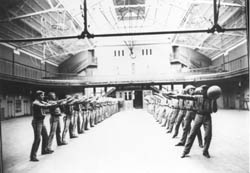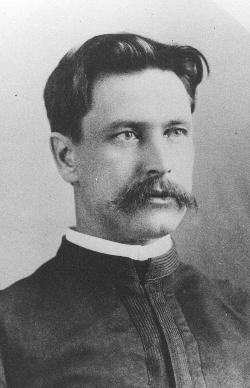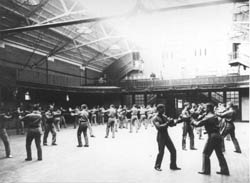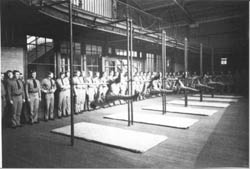THE RETIREMENT OF COLONEL KOEHLER
From the 1924 Pointer
United States Corps of Cadets
| It was on February 1, 1885, that Herman J. Koehler reported to Colonel Wesley Merritt, then
superintendent, as Master of the Sword of the United States Military Academy. And on that
day it may justifiably be stated that modern Army Physical Training began. The gymnasium,
which measured 13x25x60 feet, boasted of equipment consisting of one horizontal bar, two
wooden horses, one life size and one colt size, a swing, parallel bars, four feet high and
twenty feet long, nailed to the floor, and some clubs and dumbbells of antiquated size and
weight. |

|
However, the
beneficial effects of the system of instruction introduced by Colonel Koehler were so
readily apparent that in 1892 a new gymnasium was completed and instruction expanded to
include fencing, swimming, and gymnastics. In 1905 another advance was accomplished when
boxing and wrestling were added to the Academy’s physical curriculum, instruction
being extended at the same time to include the entire Corps. Five years later witnessed
further recognition of the Koehler system of physical education when the present modern
gymnasium was constructed. In 1920, the present course of physical and intramural athletic
training was inaugurated, thereby establishing the Military Academy without a peer the
world over.
In addition to his success at West
Point, Colonel Koehler had distinguished himself prior to his service in the Army.
Beginning physical training at the age of eight, he won the national championship in all
around gymnasium and athletics at the age of nineteen. In 1880 he emerged with second rank
in an international competition held at Frankfort-on-the-Main, the competitors numbered
over five hundred. The following year Colonel Koehler attended as an on-looker a national
competition staged in the same city. Upon discovery of the fact that the man who won first
place the preceding year was competing, he entered the lists despite the fact that he had
not trained for the event. The results placed Colonel Koehler first against a field of
three hundred.
The recent World War supplied him
with another opportunity for distinguished service to his country. Placed in charge of the
disciplinary physical training in the Officers and Divisional Training Camps of the
National Army, he personally instructed over 200,000 men, of whom 35,000 were aspirants
for commissions. It was not infrequent for him to lead an entire brigade of 6,000 men in
calisthenics. The Distinguished Service Medal was awarded Colonel Koehler in 1919 in
recognition of these achievements.
Previous to the war he had assisted
in the physical instruction of the New York and Massachusetts National Guard regiments in
1911, 1912, and 1913; had aided the establishment of the recruit school of the New York
Police Department in 1913; had sole charge of drill and physical instruction of the New
York quota during the Mexican border trouble in 1916; and was in command of the
disciplinary training at Plattsburg in 1915 and 1916, serving under General Underwood. In
1921 and 1922 he assisted with the C.M.T.C. camps. It is estimated that he has during his
career instructed upward of 400,000 persons, a distinction, which certainly has never been
equaled.
Since the time of Colonel Thayer no
officer has left the imprint of his personality and character so firmly imbedded in the
atmosphere and spirit of West Point.

|
On December 14th,
Lieutenant Colonel Koehler
was retired.
The Corps extends to Colonel Koehler thanks for all that he has done for West
Point, and for all that he has accomplished, by precept and practice, for generation after
generation of cadets. Its good wishes are with him for many more years of activity among
them. The Army Athletic Association has obtained the services of Colonel Koehler as
Executive Manager of Athletics, thus assuring his continued co-operation in the further
development of the athletic system he has developed. |
A conversation
with LTC Herman J. Koehler and his friends
Heaven’s Gym #1 is located just inside the
Pearly Gates, in the Old Section. Most new arrivals to the afterlife train further out in
gyms that look much like ours here on earth. Old-timers like LTC Herman J. Koehler and his
friends train at HG #1. It has many rooms. Ladders, ropes, traveling rings, trapezes, and
other amazing devices hang from the walls and ceilings. Wrestlers, boxers and gymnasts
fill the main floor. Above the door at the main entrance there is a quote by Rudyard
Kipling:
"Nations have passed away and
left no trace,
and history gives the naked cause of it--
one single, simple reason in all cases;
they fell because their people were not fit."
Koehler is still in great shape as he prepares to
celebrate his 140th birthday this year on December 14. Folks in Heaven are
generally uninterested in our terrestrial adventures, but civility is still the standard
there. If we listen carefully, they will speak.
KOEHLER: I understand that you are with the U.S. Army
Physical Fitness School. Do you know who I am?
THOMAS: You were Master of the Sword at the United
States Military Academy from 1885 until 1923, and you are certainly the "Father of
Modern Army Physical Readiness Training."
KOEHLER: I died in 1927, but my system was losing
ground when I retired in 1923. How do you still know of me?
THOMAS: Fragments of your work can still be found in
archives at West Point, and you were the driving force behind the Army’s first
physical training manuals. Captain Robert Degan wrote about you in his Master of Science
thesis in physical education at the University of Wisconsin in 1966. He was killed in Viet
Nam a few years later.
KOEHLER: I know. He is here with us now.
THOMAS: What was the source of your unparalleled
genius for Army physical training.
KOEHLER: I was born in Milwaukee, Wisconsin in 1859.
My parents were German and deeply involved in the Turnvereine, and I began training when I
was a child.
THOMAS: What is the Turnvereine where did it come
from?
KOEHLER: During the early 19th Century, Germany was
weak and divided into hundreds of independent sovereignties that were no match for
Napoleon's mighty army. Friedrich Ludwig Jahn, the Father of German
Gymnastics, was not yet 30 years of age when he rushed to help defend Prussia at
the Battle of Jena in 1806. He arrived to witness overwhelming defeat, the loss of almost
half of his beloved homeland, and its eventual occupation by 150,000 French. Jahn
eventually inspired a system of physical training that transformed the nation. Here he
comes now. Turnvater Jahn, this rookie wants to know about the Turner system of
gymnastics.
JAHN: I was born in
Prussia on August 11, 1778 and grew up longing for a good education. Unfortunately, the
schools were decadent. I spent my youth as an outsider to the inertia, drinking, and
fighting that dominated much of the academic environment. I spoke out against the decay
and was dismissed from numerous universities. My real education came from wandering
throughout the countryside and coming to love my troubled nation with a fervor that
aroused all I met along the way. Between my retreat from Jena and the War of Liberation,
which eventually led to the defeat of Napoleon at Waterloo, I began teaching at Graue
Kloster, a boys’ school in Berlin. There I planted the seeds for a system of
gymnastics that transformed German physical culture.
Gymnastics is not merely the means of augmenting physical powers, but a tool for
achieving political goals as well. German freedom and strength revolved upon the youth of
the state and, therefore, the supreme aim of physical education was to develop sturdy
citizens possessing a love of their homeland and the aggregate strength to throw off the
rule of the oppressor from either outside or inside the nation.
A wave of patriotism followed the defeat at Jena, and
my call for action made me a national hero. By 1814, I was even receiving a government
salary, and the Turnvereine Gymnastic Societies grew rapidly. I had inspired a nation of
citizen-soldiers. After Germany was liberated, the Turners joined the call for more
personal and political freedom. The government reacted. Many Germans had hoped that
Napoleon's defeat would be followed by national unity under constitutional rule. Instead,
the monarchs banned the Turnvereine.
I was eventually arrested and jailed. It took around
five years for me to be free of charges. It all eventually led to a failed and bloody
revolution in1848. Thousands of Germany’s best and brightest fled their homeland, and
many chose America. I stayed behind in Germany and died a few years later in 1852.
KOEHLER: The first American Turnvereine opened in
Cincinnati. Twenty-two Turner Societies were operating in the United States by 1851. Ten
years later, the Turners, vehemently opposed to slavery, were among the first to volunteer
as units in the Northern Army. Of an estimated 10,000 active Turners, approximately 6,000
enlisted. Many of them were lost in battle.
THOMAS: I have read that the Turners fought valiantly
during the Civil War, and afterwards, many school districts eventually began to adopt the
Turner physical education system. What role did you play?
| KOEHLER: I studied in the Turnvereine
throughout my youth and graduated in 1882 from the Milwaukee Normal School of Physical
Training, a Turner school. My uncle, George Brosius, directed it. He fought bravely in the
Civil War and later served as superintendent of Physical Training in the public schools of
Milwaukee from 1875 to 1883. After graduating, I worked for a while teaching and building
physical education programs in Wisconsin schools. In 1885, I was appointed Master of the
Sword at West Point Military Academy. |

|
THOMAS: An 1889 report to the Board of
Visitors at the Military Academy in 1889 stated:
"We confess that it was exceedingly difficult to
believe that the gymnastic exercise performed by the fourth class could be the result of
only one year of practice under the instruction by Professor Koehler. The feats of agility
were simply wonderful; they are valuable chiefly as evidence of sound, muscular, trained
bodies. Professor Koehler is an accomplished teacher."
How did you do that?
KOEHLER: My system had four main functions: To build
the men up physically, to wake them up mentally, to fill them with enthusiasm, and to
discipline them." I believe that mechanical proficiency through physical training is
essential for self-reliance, courage, and personal discipline. I further argued that the
discipline of the individual determines the discipline of the mass.

|
THOMAS: What is discipline? KOEHLER: It is the voluntary, intelligent, coordinated and cheerful
subordination of every individual in an equal degree with every other individual of the
mass to which he belongs, and of which he is an interdependent and not an independent
unit, through which the object of the mass can be attained. Discipline is behavior that
punishment unnecessary. In order to be disciplined, a soldier must be committed to ideals
larger than himself. The disciplinary value of military physical training should equal, if
not surpass its purely physiological value. |
| THOMAS: Did
the Army ever fully embrace your ideas? KOEHLER: No. In the early 1900s, sports and games gradually began to replace
rational physical training. What is Army PRT like these days?
THOMAS: We could use a few guys like you.
KOEHLER: Stop by again sometime.
THOMAS: Thanks. I will.
Quelle/Source:
Dr. Thomas (USA), UNITED STATES ARMY PHYSICAL FITNESS SCHOOL |

|
|




